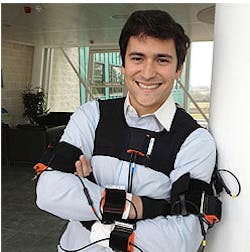Kinect-based system optimizes weightlifter's performance
A computer system which provides 3-D feedback on weightlifting performance has been developed by aLancaster University (Lancaster, UK) scientist.
The system, which was designed by Eduardo Velloso, a second year PhD student at the university's school of computing and communications, provides intricate information on a weightlifter's performance ensuring, for the first time, that advice on technique is can be instantly and accurately monitored and relayed in real-time.
The system uses a Microsoft Kinect depth camera to monitor 3-D movement and an LCD display to show if the weightlifter is undertaking the moves in the right way, position and speed. In tests, weightlifters that used the system showed a significant improvement in their performance.
Now, Velloso, a computer engineering graduate of the Pontifical Catholic University of Rio de Janeiro, plans to tackle another project that will see him attempt to analyze movement to determine the emotions a person is experiencing.
"Previous work in emotion recognition has focused on facial and voice recognition. We are now trying to achieve this by looking as users' bodily expressions. We could use this method in systems to help users in improving their body language for specific situations such as a job interviews or public speaking," he says.
A conference paper by Velloso entitled "Qualitative Activity Recognition of Weight Lifting Exercises," which was published in the Proceedings of the 4th Augmented Human International Conference held in Stuttgart, Germany in March, is available here.
Related items from Vision Systems Design that you might also find of interest.
1.How accurate is the Kinect?
An assistant professor at the Faculty of Geo-Information Science and Earth Observation of the University of Twente (Enschede, The Netherlands) has written a technical paper that analyses the accuracy and resolution of the depth data from the Microsoft Kinect sensor.
2.Kinect gets a grip on gait recognition
Researchers at the Ludwig-Maximilians University (Munich, Germany) have built a system using Microsoft's Kinect sensor to identify individuals from their gait.
3.Kinect helps to find objects in complex scenes
Researchers at the Helsinki Institute for Information Technology (HIIT; Helsinki, Finland) and the Max Planck Institute for Informatics (Saarbrücken, Germany) have developed a computer vision-based tracking system with vibrational feedback that can be used to steer a user's hand towards an object of interest.
-- Dave Wilson, Senior Editor,Vision Systems Design
